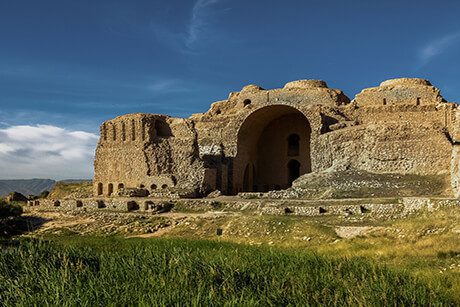The Sassanid Archaeological Landscape, A UNESCO Heritage Site
Fars province is one of the most beautiful provinces of Iran, which has many historical monuments and tourist attractions. One of these areas is the Sassanid Archaeological Landscape of the Fars region, which is an important cultural heritage and is registered in the UNESCO World Heritage list. Fars province has historically been the capital and center of many dynasties, including the Parthians, Achaemenids, and Sassanids, and forms an important part of Iranian history. During the reign of these dynasties, many structures were built that are among the historical and ancient monuments today.
Read More:
- UNESCO World Heritage Sites of Iran
- Persepolis, A Manifest of the Persian Empire
- Pasargadae, Tomb of Cyrus the Great
- Iran UNESCO Tours
Studies by archaeologists, historians, and researchers indicate that Fars province has been used as the capital of the Sassanid Empire for 400 years. The Sassanid Empire is one of the most prominent periods in the history of Iran, during which the Iranian civilization reached its peak. The Sassanid Empire coincided with the Byzantine Empire in Rome, and for this reason, in terms of culture and architecture of that time, there are similarities between these two civilizations.
According to archaeological research in Fars province, about 3,000 historical monuments have been found that are related to the formation of the Sassanid archaeological landscape and this indicates the strong presence of the government in that area. The historical artifacts discovered in the Sassanid archeological landscape are mostly related to the cities of Bishapour, Firoozabad, and Sarvestan.
There are also several road routes in this area that were built during the Sassanid period. The Sassanids strengthened the basis of the culture and civilization of ancient Iran in this region, which was done by building beautiful and magnificent works and unique buildings. Ardeshir Palace, Anahita Temple, the ancient city of Gore, Sasan Palace, and stone inscriptions are just a part of the Sassanid archaeological landscape of the Fars region.
Dokhtar Castle in Firoozabad
Dokhtar (girl) Castle (Qal-e Dokhtar) in Fars province is located six kilometers from the Firoozabad – Shiraz road at the foot of a mountain overlooking the road, which can be reached after a distance of about 300 meters.
This castle was built to protect the Sassanid capital by the order of Ardeshir Babakan and until the end of the Parthian rule, it was the fortress of Mohammad for protection and guarding. Although the castle has suffered a lot of damage, its high walls still show the establishment of a strong government. The location of Dokhtar Castle on the mountain and its surroundings on three sides has made this Castle have a strategic position
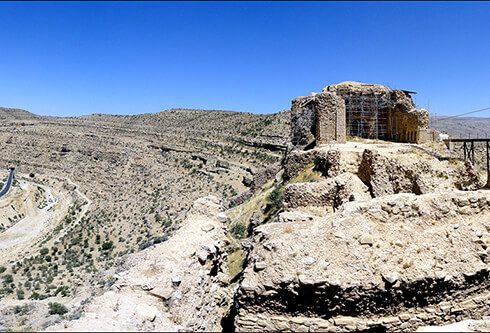
This castle has an area of 2300 square meters, which is formed in 3 floors in a stepped manner. The floors are extended by spiral staircases to the highest part of the castle. If we look at the Dokhtar castle from above, we will notice its rectangular shape, as well as a large crescent-shaped dome that is built on a large square room. This square room is located in the highest part of Dokhtar Castle. The surviving evidence shows that this was a noble and ceremonial part of Qala-e Dokhtar.
Lithograph of Ardeshir’s victory over Ardavan in Firoozabad
The prominent lithograph of the cavalry battle in Firoozabad is one of the most beautiful lithographs of the Sassanid period, depicting the battle of Ardeshir Babakan, the founder of the Sassanid government, with the fifth army of the last Parthian king, in 224 AD. This historical monument is engraved on the rock wall of Tangab valley and can be seen on the way from Firoozabad to the ancient city of Gore and with 18 meters in length and 4 meters in height, it is the largest lithograph left from ancient Iran.
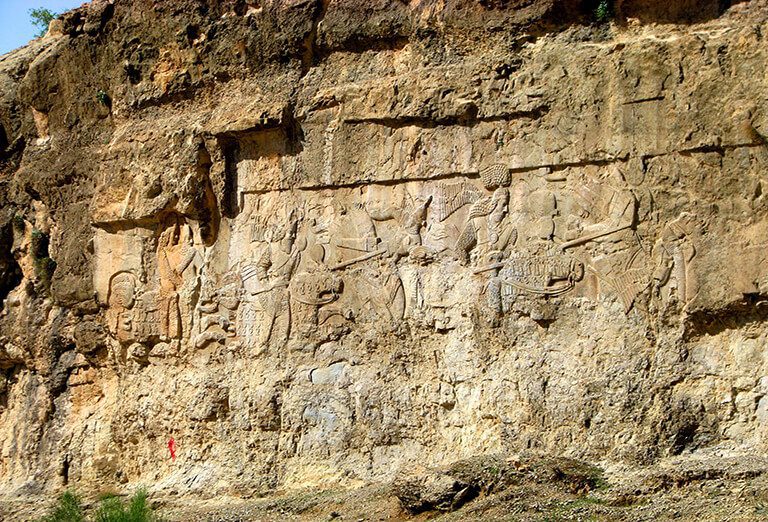
The lithograph depicts six warriors on horseback, fighting in pairs. The right side of Ardeshir Babakan is overthrowing the Fifth Ardavan with a spear on the ground. In the middle of the lithograph, Shapur, the son of Ardeshir, attacks Dadband, the minister of Ardavan, and the last warriors show the Parthian knight and the Sassanid nobleman struggling. This work depicts the art of Persian speakers by depicting many details, such as war weapons, people’s hair and beards, and decorations hanging from horses.
Lithograph of the coronation of Ardeshir Babakan in Firoozabad
The lithograph of the kingdom of Ardeshir Babakan is one of the lithographs of Ardeshir Babakan which is located in Firoozabad. In this lithograph, Ahuramazda and Ardeshir Babakan stand opposite each other, and Ahuramazda, while giving the royal ring to Ardeshir from the altar of fire, appoints him king. The masonry of this image has moved far away from the Parthian works and has tended to the common Achaemenid patterns.
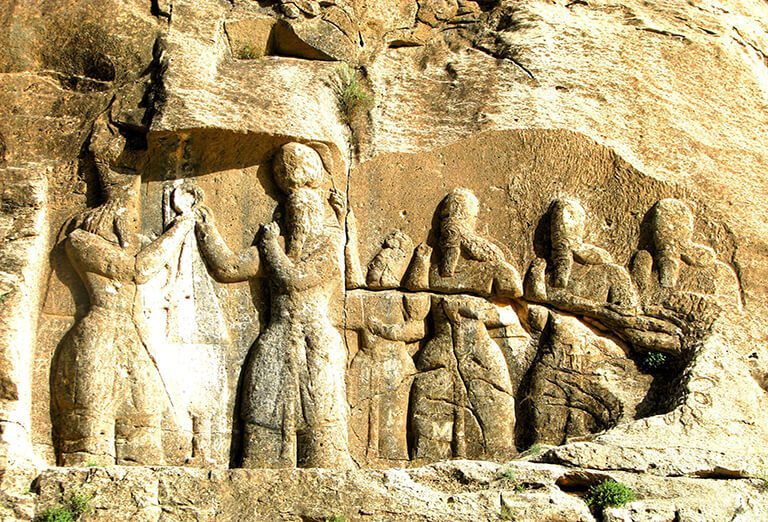
The historic city of Ardashir Khurreh in Firoozabad
100 km from Shiraz, there is one of the most historic and beautiful cities of Fars province, which has been in the hands of a kingdom for many years, whose strange interests and ambitions changed the fate of history. If you ask about the antiquity of this city, it should be said that it dates back to the Achaemenid period and the invasion of Alexander, and finally to the late Parthian period and the beginning of the formation of the Sassanid rule.
The founder of the ancient city of Ardeshir Khoreh (the city of Gore) was Ardeshir Babakan and it was built during the Sassanid era. Ardeshir Babakan founded a large city on the remains of a city that was impenetrable during the Achaemenid period but was destroyed by Alexander’s attack.
The view of the city is circular from above, its concentric streets consist of four main sections and four gates of Mehr, Hormozd, Bahram, and Ardeshir. Each of these four sections is divided into five sections and the whole city is divided into twenty sections. The city is surrounded by barriers and wide ditches to protect it from any damage.
In the middle of the city, a palace with high minarets was built, which according to historians was a symbol of the goddess of water. Ardashir called this city Ardeshir Khoreh and declared the official religion of the people as the religion of Zoroaster.
Various theories have been proposed regarding the construction of this minaret:
- Existence of the minaret as a symbol of the king’s power
- Existence of a minaret to circle the city and facilitate the construction of the city
- Contact Dokhtar castle for information about enemy attacks
- Place of worship
There are many historical structures in this historic city. Until many years ago, the Maragheh Observatory was known as the oldest observatory in Iran (It was built in 657 AH.), but now the observatory discovered in the ancient city of Gore, which is 300 years older than the Maragheh Observatory, is the oldest observatory in Iran. This observatory is considered a masterpiece of Iranian knowledge at that time. The astronomical tower found in the city of Gore is made of clay and mud and is completely intact. It has a diameter of about 5.65 meters, on which there are 12 signs of symbols used in observational and graphical measurements.
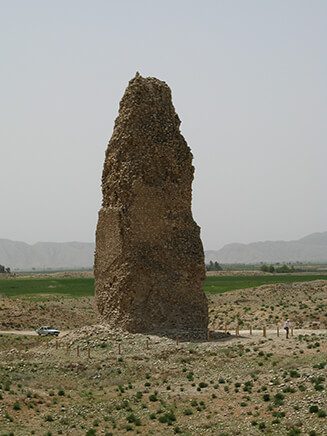
Ardeshir Babakan Palace in Firoozabad
One of the most valuable antiquities left from the Sassanid rule is the palace of Ardeshir Babkan in Firoozabad city of Fars province, which has attracted the attention of domestic and foreign tourists with its unique architecture and structure. This palace is also called Firoozabad Fire Temple because it is the largest Fire Temple in Fars province.
Beautiful and eye-catching plaster decorations are one of the Iranian skills that show themselves in this mansion. But the most interesting and important thing about Ardeshir Babakan Palace is the strength of its decorations. Because after eighteen hundred years since the construction of this building, many parts of it still remain firmly above the inner walls.
From the decorations that can be seen inside the palace, it is clear that in the delicate plastering of the cornices on the columns, the stone cornices of Persepolis have been imitated. Another interesting and amazing point of Ardeshir Babakan Palace is the presence of a windbreak on the walls of the palace, which has been placed in order to allow air to flow in the rooms and hall.
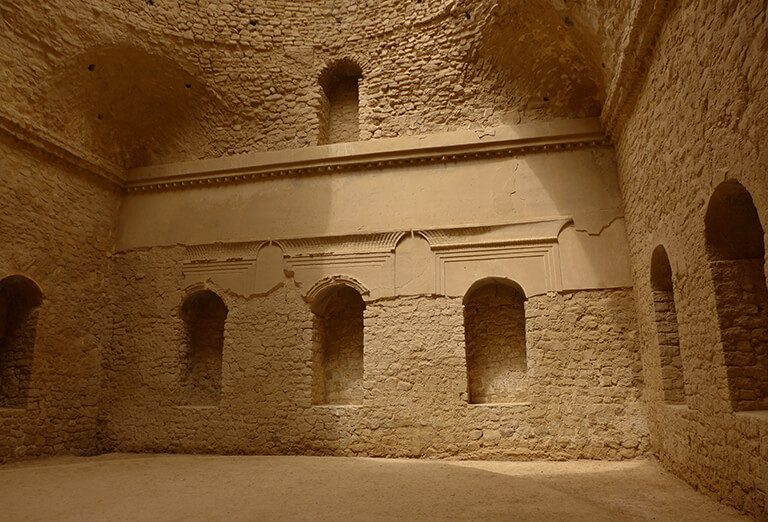
City of Bishapour
The historic city of Bishapour is located 120 km south of Shiraz. Bishapour is located next to the royal road of ancient times, which in the Achaemenid period connected “Persepolis” and “Istakhr” to the ancient city of “Susa” and in the Sassanid period the city of “Gore” and “Bishapour” to “Ctesiphon”.
Bishapour is one of the first ancient cities to have a written history of urban planning. The history of this city is shown by an inscription with two Parthian and Sassanid lines on the pillar of the Bishapour monument. The date of construction of the city dates back to the Shahpour period and around the years 272-241 AD.
The existence of Shahpour waterfall and Sasan spring indicate the special importance of these water resources in the formation of the historical city of Bishapour. The beautiful nature of this region, which is a combination of high mountains, Shahpour river and citrus orchards and Sasan spring, has connected the historical city of Bishapour with its surroundings.
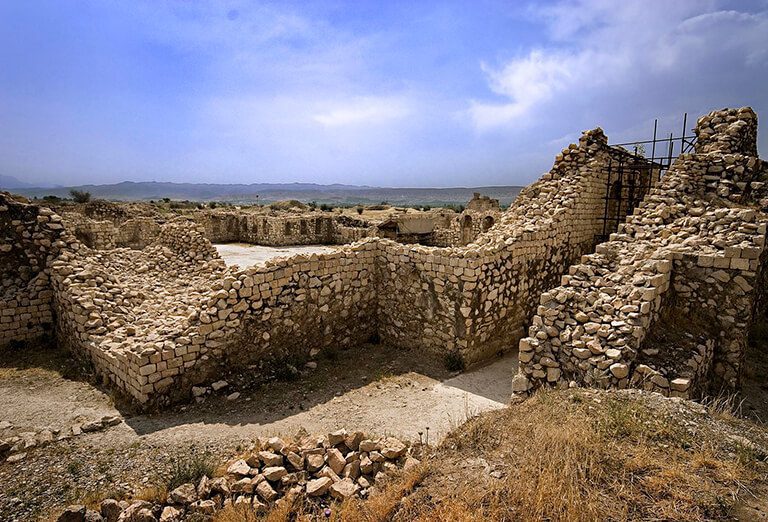
Shapur I statue
Shapur I was the son of Ardeshir Babakan, the founder of the Sassanid dynasty and one of the most powerful kings in the history of Iran. After coming to the throne, he experienced many defeats and victories and left many memories of himself. One of these relics is a statue of him in Shapur Cave, which attracts many tourists every year.
According to evidence from about 1400 to 1800 years ago, Sassanid artists built a sculpture of him inside the Shapur Cave. A 7-meter statue built on the rocks of the cave floor and on a natural stalagmite, with all the elegance and artistry, and shows the peak of the art of the artists of that time. Also, further studies revealed that it was created by carving a completely natural stone pillar in the cave.
During the Arab invasion of Iran, the historical and artistic monuments of Bishapour were destroyed by the order of an Arab general, one of which was the statue of Shapur I. Following this incident, most of the statue’s arms and legs were broken, but its head and upper body remained intact.
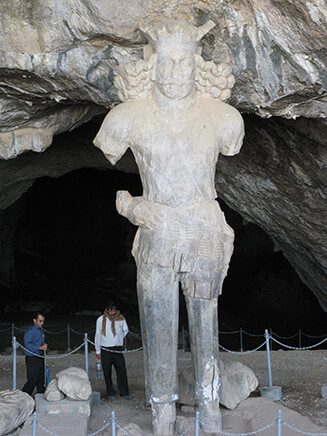
Sarvestan Sassanid Palace
Sarvestan Palace, which is the oldest brick dome in the country, was built during the reign of Bahram Gour Sassanid. The latest archeological studies in the Sarvestan Palace complex show that this Sasan complex was about 30 hectares in its heyday. The main part of this building is on the east side, which has two large and small porches. The main porch leads to the central hall and then to the courtyard. The great hall of the Sassanid Palace of Sarvestan has a high roof and a dome shape, and under its roof, the remains of a very beautiful bed are still visible and there are signs of the original art of architecture at that time.
The dome arches of this building are made of bricks. This palace has a more complex and complete architecture and plan than other buildings and works related to the Sassanid period. Most domestic and foreign scholars believe that this work belongs to the Sassanid period (in the 5th century). And confirmed the reign of Bahram V, known as Bahram Gore.
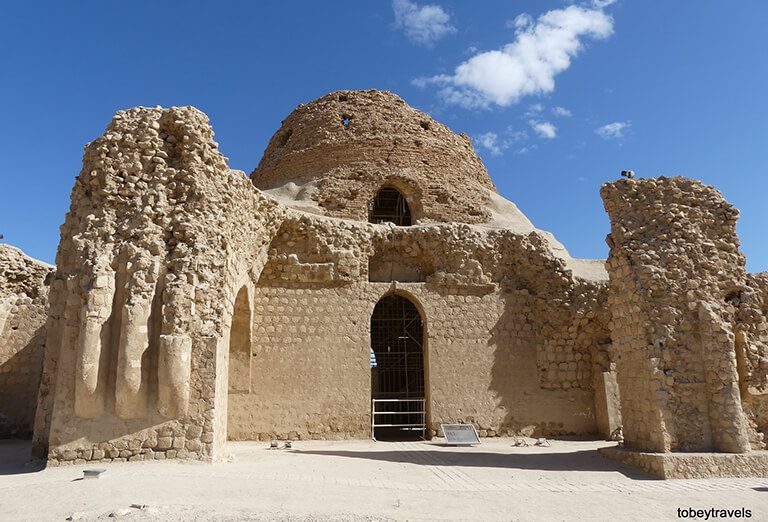
In general, the Sassanids strengthened the basis of the culture and civilization of ancient Iran, especially in Fars province, which was done by building beautiful and magnificent works and unique buildings. Ardeshir Palace, the ancient city of Gore, Sarvestan Palace, and stone inscriptions are only part of the Sassanid archaeological landscape of the Fars region. You can easily choose your Iran tour package from below or create your own package to see the history leftover from the Sassanid era in Iran.

